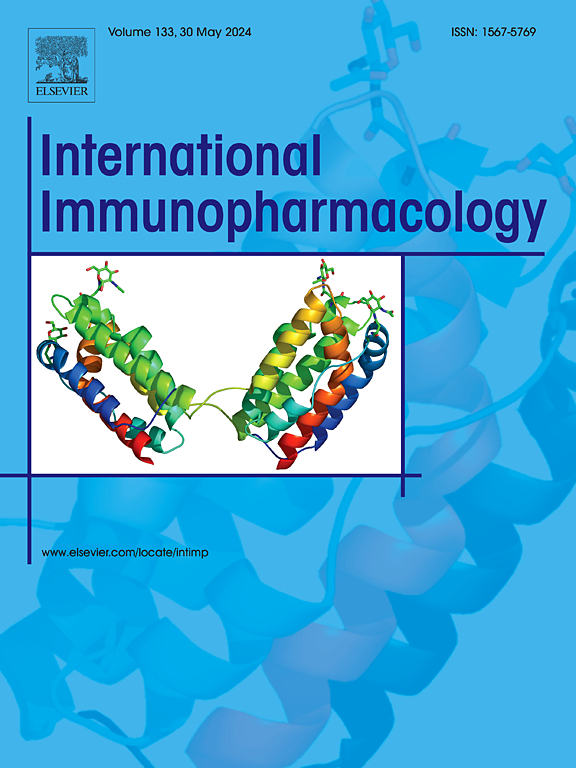山奈酚通过抑制肺泡上皮细胞胞外囊泡介导的肺泡巨噬细胞活化,减轻脓毒症相关急性肺损伤
IF 4.8
2区 医学
Q2 IMMUNOLOGY
引用次数: 0
摘要
急性肺损伤(Acute lung injury, ALI)是脓毒症最严重的并发症,但目前缺乏有效的治疗方法。因此,寻找治疗脓毒症引起的急性肺损伤(SALI)的药物是临床迫切需要解决的问题。山奈酚已被证明对各种肺部疾病有治疗作用。采用盲肠结扎穿刺法(CLP)建立小鼠脓毒症模型。通过小鼠尾静脉注射小鼠血浆外泌体和肺泡上皮细胞分泌的外泌体,采用western blotting、PCR、流式细胞术等技术检测小鼠肺损伤和巨噬细胞活化情况。我们的研究表明山奈酚缓解SALI的作用部分依赖于细胞外囊泡机制。与对照组相比,CLP组小鼠血浆外泌体含量增加,这些血浆外泌体在肺部聚集更多,促进肺泡巨噬细胞过度活化。然而,山奈酚治疗降低了CLP小鼠血浆外泌体的水平,并抑制了外泌体对肺泡巨噬细胞和肺组织的有害影响。通过生物信息分析和体外、体内实验,我们进一步发现山奈酚影响的血浆外泌体通过抑制MAPK信号通路发挥作用,并且这些作用被MAPK抑制剂放大。我们发现受山奈酚影响的血浆外泌体来自肺泡上皮细胞。本研究提示山奈酚可通过降低肺泡上皮细胞胞外囊泡介导的MAPK信号通路,抑制巨噬细胞活化来缓解SALI。本文章由计算机程序翻译,如有差异,请以英文原文为准。
Kaempferol alleviates sepsis related acute lung injury by inhibiting the activation of alveolar macrophages mediated by extracellular vesicles from alveolar epithelial cells
Acute lung injury (ALI) is the most serious complication of sepsis, but there is currently a lack of effective treatment methods. Therefore, finding drugs to treat sepsis induced acute lung injury (SALI) is an urgent clinical problem that needs to be solved. Kaempferol has been proven to have therapeutic effects on various lung diseases. We used cecal ligation puncture (CLP) method to create a mouse model of sepsis. Mouse plasma exosomes and exosomes secreted by alveolar epithelial cells were injected into mice via tail vein, western blotting, PCR, flow cytometry, and other techniques were used to detect lung injury and macrophage activation in mice. Our research shows that the therapeutic effect of kaempferol in alleviating SALI partially depends on the extracellular vesicle mechanism. Compared with the Control group, the CLP group mice showed an increase in plasma exosome content, and these plasma exosomes gathered more in the lungs and promoted overactivation of alveolar macrophages. However, treatment with kaempferol reduced the levels of plasma exosomes in CLP mice and inhibited the harmful effects of exosomes on alveolar macrophages and lung tissue. Through biological information analysis and in vitro and in vivo experiments, we further discovered that the plasma exosomes affected by kaempferol exert their effects by inhibiting the MAPK signaling pathway, and these effects were amplified by MAPK inhibitors. And we found that the plasma exosomes affected by kaempferol come from alveolar epithelial cells. This study suggests that kaempferol can alleviate SALI by reducing the MAPK signaling pathway mediated by extracellular vesicles in alveolar epithelial cells and inhibiting macrophage activation.
求助全文
通过发布文献求助,成功后即可免费获取论文全文。
去求助
来源期刊
CiteScore
8.40
自引率
3.60%
发文量
935
审稿时长
53 days
期刊介绍:
International Immunopharmacology is the primary vehicle for the publication of original research papers pertinent to the overlapping areas of immunology, pharmacology, cytokine biology, immunotherapy, immunopathology and immunotoxicology. Review articles that encompass these subjects are also welcome.
The subject material appropriate for submission includes:
• Clinical studies employing immunotherapy of any type including the use of: bacterial and chemical agents; thymic hormones, interferon, lymphokines, etc., in transplantation and diseases such as cancer, immunodeficiency, chronic infection and allergic, inflammatory or autoimmune disorders.
• Studies on the mechanisms of action of these agents for specific parameters of immune competence as well as the overall clinical state.
• Pre-clinical animal studies and in vitro studies on mechanisms of action with immunopotentiators, immunomodulators, immunoadjuvants and other pharmacological agents active on cells participating in immune or allergic responses.
• Pharmacological compounds, microbial products and toxicological agents that affect the lymphoid system, and their mechanisms of action.
• Agents that activate genes or modify transcription and translation within the immune response.
• Substances activated, generated, or released through immunologic or related pathways that are pharmacologically active.
• Production, function and regulation of cytokines and their receptors.
• Classical pharmacological studies on the effects of chemokines and bioactive factors released during immunological reactions.

 求助内容:
求助内容: 应助结果提醒方式:
应助结果提醒方式:


